UK Land Reptiles - slippery customers
There are six native species of land dwelling reptiles in the UK, three snakes and three lizards. Except for the avid naturalist, few of them would sit near the top of a wish list of 'must see' British wildlife but, as Peter Britton explains, they are fascinating creatures and worthy of further investigation and our protection.
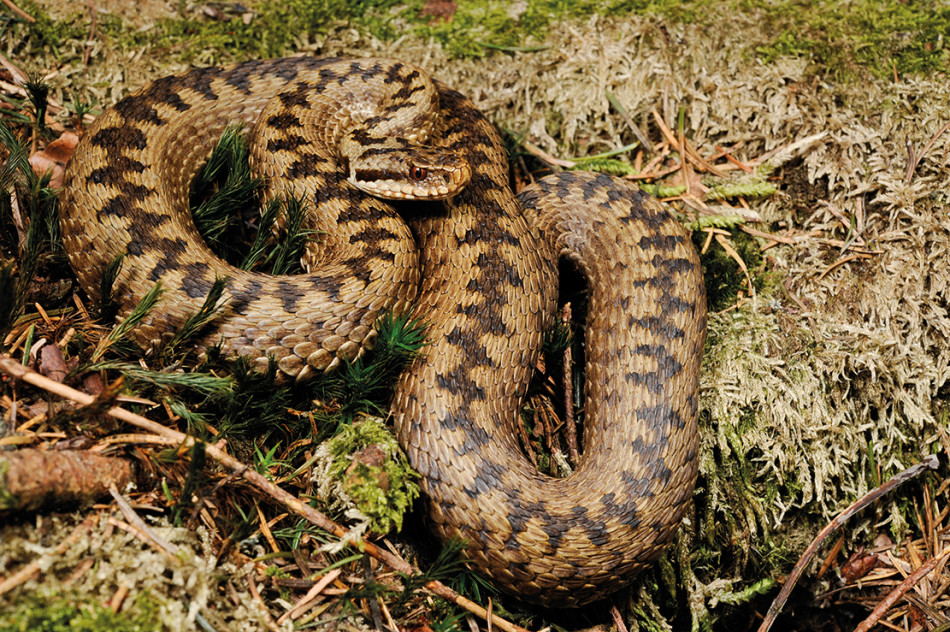
There are eleven native species of reptiles in and around the UK; three snakes, three lizards and five turtles. In addition, there are a number of introduced and escaped species that have become naturalised. It is now illegal to introduce any wild species into the UK without proper authority.
For the purposes of this article, I will concentrate on the land dwelling reptiles. If you have turtles at your facility, you really do have flooding issues!
The three native snake species are the Adder, also known as the Viper (Vipera berus), grass snake (Natrix natrix) and the smooth snake (Coronella austriaca). There are two colonies of the Aesculapian rat snake (Zamenis longissimus), one in North Wales and one in Regents Park, London.
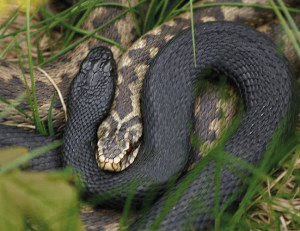
The adder is the UK's only venomous snake. They are not regarded as being especially dangerous or aggressive and usually only bite when alarmed or disturbed. Whilst the bites can be very painful, they are seldom fatal. However, being bitten by a three foot long snake can, understandably, be rather alarming. That said, incidences of adder bites are rare (around a hundred a year) and hospitalisation is not usually required. The last death from an adder bite was in 1975; a five year old boy. You are more likely to die from a bee sting!
They are instantly recognisable by the zig-zag pattern running the full length of their body and strong 'V' marking on their head. Unusual in snakes, males tend to be lighter in colour than females, whilst the rarer black version is actually dark brown, but still carries the zig-zag markings, should you care to get close enough to look!
It feeds on small mammals, birds, lizards, and amphibians and, in some cases, spiders, worms and insects. They are ovoviviparous, i.e. they produce eggs but, instead of laying the eggs, they develop within the mother's body and hatch within the mother. Females breed once every two or three years, with litters usually being born in late summer to early autumn. Litters range in size from three to twenty, with the young staying with their mothers for just a few days.
Adults grow to a total length (including tail) of between 60-90cm (24-36in). Their bodies are stocky rather than slender.
Habitat complexity is a crucial requirement in order to support its various behaviours - basking, foraging and hibernation (about 15% of adults and 40% of juveniles die during hibernation) - as well as to offer some protection from predators and human harassment.
Adders are found in various habitats; complexity being essential for the different aspects of its behaviour, including chalky downs, rocky hillsides, moors, sandy heaths, meadows, rough commons, edges of woods, sunny glades and clearings, bushy slopes and hedgerows, rubbish dumps, dunes and stone quarries. It will venture into wetlands if dry ground is available nearby and can, therefore, be found on the banks of streams, lakes and ponds.
Their range extends across England, Wales and Scotland, but are absent from Ireland. Indeed, there are no snakes to be found in the Emerald Isle, apparently because St. Patrick chased them out!
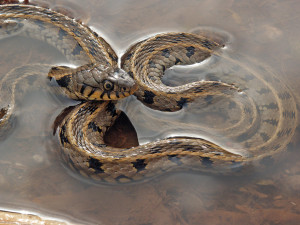
Grass snakes are similar in size to adders, but with a more slender body. They vary in colour from green to brown with a characteristic yellow collar behind the head that makes then easily distinguishable. They are non-venomous.
Their diet consists almost exclusively of amphibians, especially the common toad and the common frog, although they may also occasionally eat ants and larvae.
Grass snakes are strong swimmers and may be found close to fresh water, although they do not need bodies of water throughout the entire season. Their preferred habitat is open woodland and fringes such as field margins and woodland borders, as these offer adequate refuge while still affording ample opportunity for thermoregulation through basking. Pond edges are also favoured and the relatively high chance of observing this secretive species in such areas may account for their perceived association with ponds and water and gives rise to their alternative name of Water snake.
As spring approaches, the males emerge first and spend much of the day basking in an effort to raise body temperature and thereby metabolism. This may be a tactic to maximise sperm production, as the males mate with the females as soon as they emerge, which is generally two weeks later.
The females lay leathery-skinned eggs in batches of eight to forty in June and July and these hatch after about ten weeks. To survive and hatch, the eggs require a temperature of at least 21°C, but preferably 28°C, with high humidity. Rotting vegetation, such as compost heaps, are preferred locations. The young are about 18cm (7in) long when they hatch and are immediately independent.
Grass snakes, as with most reptiles, are at the mercy of the thermal environment and need to overwinter in areas which are not subject to freezing. Thus, they typically spend the winter underground where the temperature is relatively stable.
They are commonly found across England and Wales, but are absent from Scotland and Ireland.
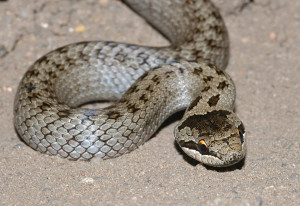
The smooth snake is non-venomous and very rare in the UK. It is confined to the heathlands of the south of England and is the smallest of the native species, growing to a maximum of 75cm (30in).
It is superficially similar in appearance to the adder, but can be distinguished by a number of features, including a rounder head and longer, slender body. It is brown or grey in colour and has dark spots on the upper surface rather than the zig-zag pattern characteristic of the adder. The eyes have a round golden iris and the head is brown with a black crown - giving rise to its latin name, (Coronella austriaca) - and black eye stripes. Its name refers to the scales, which lack the 'roughness' of the two other British snakes.
Smooth snakes feed on smaller animals, especially other reptiles (including other smooth snakes - no wonder it's rare) and subdue larger prey by constriction, although, unlike true constrictors, do not actually kill by this method.
This snake is extremely secretive, spending much of its time in crevices, holes in the ground, under stones, in loose sand and soil or concealed in litter and vegetation. When basking, they often wrap themselves around heather in order to camouflage themselves.
Little is known about their reproduction, but it is thought that they breed every other year, with mating occurring in April, May and early June. Like adders, smooth snakes are ovoviviparous; the young are born live in September and October and may hibernate immediately after birth, emerging the following year, usually in March.
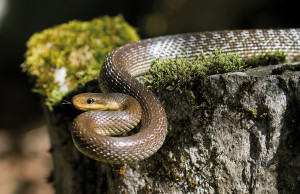
The Aesculapian Rat Snake first arrived in the UK during the mid-sixties when the founder of the Welsh Mountain Zoo imported reptiles from Italy. At some point, the snakes must have escaped into the zoo grounds and started breeding.
The first indication of their presence was when baby snakes were found in the zoo grounds in the early seventies which were first thought to be grass snakes due to the yellow marking on their head.
Over the next thirty years, occasional adults and babies were observed at the zoo in Colwyn Bay, only very rarely being found outside the grounds. The snakes have remained at the zoo grounds and surrounds and have not spread.
The Aesculapian snake is a harmless, non-venomous species which feeds mainly on rodents, which might suggest why they have stayed close to the zoo. Their presence is deemed as beneficial due to a decrease in the number of rodent pests.
They are native to central Europe and are already a foot long when they hatch, before growing to their adult length of four to five feet. Some have been recorded growing to a length of eight feet!
A second colony was found living close to the Regent Canal in Regents Park a few years ago, prompting the tabloids to warn people to "lock up their cats and dogs". In truth, they pose little or no threat to pets.
Similar to the Welsh colony, it is believed they originally escaped from London Zoo and have chosen to stay close by due to the abundance of suitable prey.
Even though it is thought they have been resident since the mid-seventies, discussions are ongoing regarding a possible cull. This has prompted Dr Wolfgang Wuster of Bangor University, who works with the Welsh colony, to call any proposal "a waste of resources".
He said: "Any attempt to eradicate the Aesculapian snake would require justification of resources to be devoted to an almost certainly non-problematic introduced species with little prospects of spread, as opposed to the many far more damaging species already out there."
"From a wider and more philosophical point of view, we should ask ourselves what we can really conserve."
Lizards
The three species of UK lizard are the Slow-worm (Anguis fragilis), Common or Viviparous lizard (Lacerta zootoca vivipara) and the Sand lizard (Lacerta agilis).
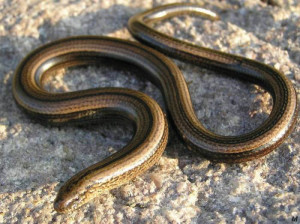
The slow worm is a legless lizard (no, it hasn't fallen into a flagon of beer), and is often mistaken for a snake. However, there are certain features that distinguish a slow worm from a snake, including the presence of eyelids and ear openings.
It can be locally abundant and it is likely to be the most commonly seen reptile. Adults have a smooth, shiny appearance, with a grey or bluish belly. The male and female differ in appearance; the female is usually brown, copper-coloured or red on the back, with brown or black sides, often with lighter iridescent flecks. In many individuals, there is a dark stripe passing along the middle of the back and stripes running along the sides of the body. The male varies in colour, being greyish, brown or coppery brown, typically without stripes. The male usually has a broader, longer head than the female.
Occasionally, individuals may have blue spots, a feature that is more common among males than females. In juvenile slow worms, the back is iridescent silver, gold, bronze or copper and the sides are brown or black.
Depending on the climate, a female slow worm will mate annually. She is ovoviviparous; giving birth to an average of eight live young between mid-August and mid-September. The young slow worms are initially encased in the egg membrane and measure from 70 to 100 millimetres in length. It takes between six and eight years for the slow worm to become fully grown, although the male reaches sexual maturity at three or four years of age. The female becomes sexually mature at four or five years of age.
Their range extends across England, Scotland and Wales but is not native to Ireland. However, it was illegally introduced in the 1970s, but has only ever been been sighted in parts of County Clare.
Slow worms live for a long time, with one specimen known to have lived for fifty-four years!
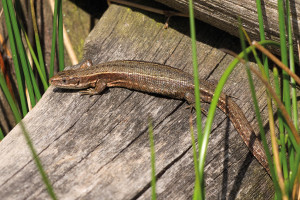
Common Lizards, as their name suggests, are widely distributed in the UK. You may find one almost anywhere from gardens, heathland, wooded glades, disused railway tracks and open meadows to the banks of ditches and along hedgerows. In spring, the males and females bask in the open to absorb the heat from the sun. Later, in the summer, it is usually only the pregnant females that are seen to bask. They will often use a stone, log or grass tussock close to cover for basking. If disturbed, they will often return to their favourite spot soon afterwards.
Up to ten young are produced in July, with the UK species giving birth to live young, whilst southern European species lay eggs. This is believed to be due to the cooler temperatures in the British Isles.
Most males and some females have dark spots in their undersides. Males have brightly coloured undersides - typically yellow or orange. Females have paler, whitish underparts. The throat is white, sometimes blue.
Their range extends across the whole of the British Isles and is the only reptile native to Ireland.
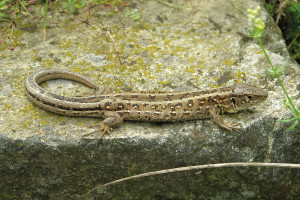
Sand Lizards are the UK's rarest reptiles. They favour sandy heathland habitats and sand dunes and can be spotted basking on bare patches of sand. They also lay their eggs in the sand. Sand Lizards are confined to a few sites as destruction of their habitat has reduced their range.
Females are a sandy-brown colour with rows of dark blotches along the back, but males have green flanks which are at their brightest during the breeding season, making them easy to spot.
Their range is restricted to a few isolated areas with sandy heaths, such as Dorset, Hampshire and Surrey, and on sand dunes in Lancashire. It has been reintroduced into other areas in the South East and Wales with limited success.
Heathland golf clubs offer ideal conditions for sand lizards.
Two 'non-native' lizard species exist in the UK; the wall lizard (Podarcis muralis) and the green lizard (Lacerta bilineata). Both are currently rare.
Wall lizard (Podarcis muralis)
The wall lizard is one particular species of European lizard that has gained a firm foothold. The Amphibian and Reptile Conservation Trust say that, whilst some populations have been introduced (now illegal), the origin of others is uncertain and it may indeed be native in some areas. This, of course, is almost impossible to ascertain.
The wall lizard is slightly larger than the common lizard, and with similar colouring, but may be distinguished by its more pointed head.
Green Lizard (Lacerta bilineata)
The green lizard has most likely escaped from captivity, having been kept for its striking green colour. Whilst adults have no difficulty surviving in the British climate, juveniles very rarely reach maturity, although, as world temperature continue to rise, this situation might change. There is one breeding colony in the south east corner of England.
At 35cm (14in) long, it is by far the largest lizard to be seen in the UK.
And finally ...
Reptiles probably sit alongside bats when it comes to the general public's perceptions of them as being somewhat unsavoury but, just like bats, they are a fascinating part of the UK's diverse wildlife and definitely worthy of further investigation and, indeed, ongoing protection.
Reptiles and the law
The Wildlife and Countryside Act 1981 covers 'wild animals'; those that are living wild or were living wild before being captured or killed. It does not apply to captive bred animals that are being held in captivity.
All native reptiles mentioned in this article are protected in Britain under this act.
The law makes it an offence to intentionally kill, injure, sell or advertise for sale any of the six native species, although there are some exceptions for captive bred animals.
The act further protects the rarest reptiles in Britain, the smooth snake and the sand lizard, by making it an offence to possess, handle, capture or disturb them.
Further information and helpful advice is available from:
The Wildlife Trusts. Visit www.wildlifetrusts.org to find your local trust.
Amphibian & Reptile Conservation Trust - www.arc-trust.org
Peoples Trust for Endangered Species - www.ptes.org
All images Wiki Commons

